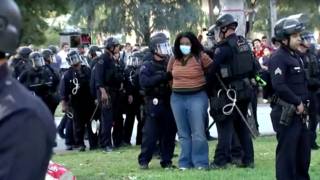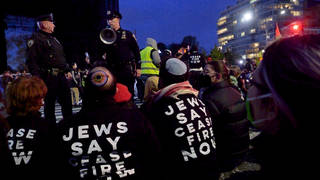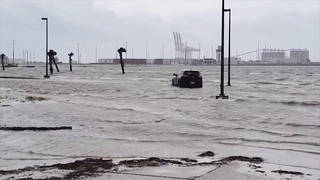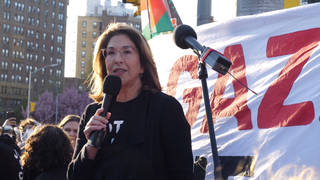
Related
Topics
Bullard speaks about ongoing issues of environmental racism in Louisiana and the aftermath of Hurricane Katrina. He raises questions about race, the communities’ distrust of federal and local agencies, and housing laws and discrimination. [includes rush transcript]
- Robert Bullard, professor of sociology at Clark Atlanta University and Director of the Environmental Justice Resource Center there. He is one of the leading authorities in the nation regarding environmental justice.
- Bush Crimes Commission
Transcript
AMY GOODMAN: We turn now to Dr. Robert Bullard. He’s a Professor of Sociology at Clark Atlanta University and Director of the Environmental Justice Resource Center, one of the leading authorities in the nation regarding environmental justice.
DR. ROBERT BULLARD: We’ve documented at least a dozen hurricanes in the South and how African American communities have fared when it comes to the response, the post-response, in terms of how government has actually dealt with aid, insurance, small business loans, how the Red Cross has dealt with it, etc., but I’m going to get to that in the next couple of minutes.
I want to get to how government has responded when it comes to terrorism, as relates to the threat posed by the possibility of the release of some type of bacteria or bio-terrorist threat. I’m sure you remember the case of the anthrax threat in Washington, D.C. It’s where — in 2001, where letters were sent and threats were sent to the U.S. Senate, and they were also sent through the U.S. Post Office, the Brentwood Section Post Office. And the Senate was immediately evacuated, and the Senate staff were immediately — predominantly white — immediately given health clearance and medical exams and the building was — the Hart Senate Office Building was quarantined, and the Senators were just cordoned, you know, pushed off and looked at, and everything was done in a way that was very efficient, thorough.
But the Brentwood Post Office — and we know who works at the post office, mostly people who look like me, was not notified until several days later. Two postal workers died. So you get treatment from one way in terms of how the government responds, in terms of health and protection of health in terms of the Senate, mostly white, and the post office, postal workers, mostly black, night and day.
So, if you talk about Homeland Security and emergency response, the fact that the government has historically responded in very different ways if the threat, the imminent threat, is against white people versus black people and other people of color. Let me just go through hurricanes. And what we did is we looked at various hurricanes, how and what happened and the damage and what the response was.
Hurricane Betsy was a hurricane that hit New Orleans, and a lot of people like to refer to Betsy. This is 1965, what happened in New Orleans and in terms of the levee breaching and the Lower Ninth Ward being flooded and the fact that there are still people in the Lower Ninth Ward who believe that the levee was breached on purpose by the mayor and his officials to save the white areas. And so, it’s — in some cases, it is an urban myth. In other cases, people believe it, and therefore, it becomes real. And probably the reason why there were fewer deaths in the Lower Ninth Ward is because people, older people who remember Betsy and remember being trapped in their attics with no way to get through, and so a lot of people during Katrina in the Lower Ninth Ward had hatchets and axes in their attics and were able to chop through, and other places. So we have the story of the breaching of the Ninth Ward — of the levee and flooding of the Ninth Ward on purpose.
Hurricane Betsy created not only devastation, but it also created a landfill that created a Superfund site in a black neighborhood, the Agriculture Street Landfill. Most of the debris from Hurricane Betsy in 1965 was put in a landfill in a black neighborhood in New Orleans, and so the people in the Agriculture Street community, Press Park area, have been fighting for decades to get their community relocated from this Superfund site. And it’s ironic that they may get their neighborhood cleaned up from this Superfund site because of Katrina. Just before December 2004, there was a major lawsuit — the lawsuit actually went to trial, and the case was declared a class action, and it’s still pending in court right now, even though the area where the landfill is located, the Superfund site, or the contamination is much wider than the site itself.
There are many neighborhoods in New Orleans now that are contaminated, whether they are Brownfields or whether they are Superfund sites is to be determined by the E.P.A. and the federal government. And so, there are concerns now that — where will all the debris go for Katrina? Will it be another Betsy, where the dump is put in another area, and the debris from the hurricane is going to be creating more and more sites for devastation?
I’ll give you an example of the way that black farmers, for example, were mistreated and discriminated against when it comes to hurricane disaster relief and loans and for droughts and floods. The black farmers sued the United States USDA, the United States Department of Agriculture, because black farmers and white farmers are treated very differently. And they won their lawsuit, and again, the fact is that this is the government. This is not some entity. This is not a corporation. This is the U.S. government, who you expect to treat everybody the same, but after natural disasters, like a flood or a drought, black farmers were not able to get their loans. They were not able to get grants. They were not able to recover from disaster, because of just in-your-face, slam-dunk discrimination.
The case of Hurricane Hugo, Hurricane Hugo struck South Carolina in 1989. And following Hugo, clear documentation in a number of reports showed that African Americans received less help than whites when it comes to this whole idea of loans, grants, something as simple as ice and something as simple as shelter. Studies that show that African Americans and poor people are most likely to spend longer times in shelter, they’re most likely to receive smaller grants and loans, even when you control for income and social class.
We have investigated this whole idea of who provides assistance in the initial hours of disasters. And we’ve shown clear documentation that oftentimes the Red Cross is not on the scene when it comes to many African American communities in many of these disasters. And Katrina is no exception. There are many communities, for example, in Mississippi right now, in many of the parts of Mississippi that were hit, in Biloxi, Gulfport and some of the other areas, that are not — that it was days before the Red Cross was seen on the scene, and so it basically was our organizations, our churches, etc., that provided the assistance. And in many cases where — communities basically say, 'Well we don't trust the government, and we don’t trust FEMA, we don’t trust the Red Cross.’ And in some cases, that trust is not based on any paranoia, it’s based on trust — it’s based on survival. The mere fact that in some cases, the Red Cross — in many of our communities in Mississippi, the Red Cross was not the Red Cross, it was the White Cross.
When we look at this whole pattern — for example, I lived in Houston in the 1980s, and there was a huge hurricane that hit Houston in 1983, Hurricane Alicia. And I had lots of damage, and if you look at — and I dealt with this in a book that I wrote called Invisible Houston: The Black Experience in Boom and Bust. That book was written in 1987. And we documented the fact that in the black wards, in Third Ward, Fourth Ward, Fifth Ward, Sedigas, Northwood Manor, Carverdale — these are all black neighborhoods, historically black neighborhoods — these areas were allowed to have debris not picked up. And there was so much debris, hurricane debris there, so much destruction, that black people started complaining. They started protesting, because debris was piling up and they needed a place to dump this debris. And so, the officials had to come up with this emergency site for this debris. And so, the place that they picked was a very poor African American community in Northeast Houston near the airport called Bordersville. It was a poor community that didn’t even have paved streets, didn’t have running water. It was basically a sawmill community. And that’s where they took all of this debris. They started burning it, created lots of problems in that area, and people were saying, 'Well, we've been hit by a hurricane. Now we’ve been hit by the city and government officials, in terms of debris being dumped on.’
What does all of this mean? It means that the disasters that hit communities oftentimes are less than, in terms of their damage, than the post-disaster kinds of activities. The fact that right now communities are struggling with housing, and they are — you know, the people before, the witnesses before testified about racism as it exists in the parishes in Louisiana. There are parishes now that are passing ordinances — that have already passed ordinances limiting the concentration of mobile homes and trailers, and the idea that in some cases, banning trailers. Well, that’s what FEMA uses for temporary housing in many cases. If you look at the fact that in many cases, communities that are struggling for, trying to find housing, they’re meeting with — African Americans, they’re meeting with discrimination in housing. I’ve worked with a lot of people in Louisiana, particularly around Baton Rouge, who are meeting housing discrimination. You know, black people show up for a unit that’s being — that has been posted for rent, and then when they show up, 'Oh, we've already rented that.’ White person shows up, 'Ok, come on in, rent it.' And so, using testing we can show that there’s clear racial discrimination, in terms of fair housing not being enforced.
So it’s not just FEMA and not just the federal government, in terms of the agencies, there are also local entities that need to enforce the laws as relates to housing. In terms of price-gouging, in terms of insurance red-lining, there are many cases of communities that can’t get insurance. And this happened before. And so, what needs to happen? There has to be strict enforcement of fair housing laws. There has to be monitoring, independent monitoring of FEMA and how resources get distributed in terms of loans, in terms of grants.
There has to be uniform clean-up standards, in terms of the Gulf Coast. In many communities of color, our communities get less clean-up. And so, the way you can kill a community easily is to not clean it up. If the Lower Ninth Ward is not cleaned up to residential standards, and basically say, 'Oh, it's not feasible to clean it up. It’s going to be industrial.’ You’ve eliminated a whole — one of the strongest voting blocks in the area and one of the strongest African American communities in the area. If you say that East New Orleans, where mostly affluent, middle-income African Americans live, is not going to be cleaned up to residential standards, you have basically eliminated politically one of the strongest parts of the city. And so environmental racism cannot only affect health, it can affect political strength and political power.
And finally, I think it’s important that people understand that the issues that I’ve looked at and that we’re looking at did not just happen in August 2005. These are issues that have been around for a long time. And the federal government, the state government and local government oftentimes have not operated in the best interest of people of color and poor people and disenfranchised people.
AMY GOODMAN: Dr. Robert Bullard, Professor of Sociology at Clark Atlanta University, Director of the Environmental Justice Resource Center there. He was speaking at the International Commission of Inquiry on Crimes Against Humanity. It took place here in New York City at the Manhattan Center.












Media Options